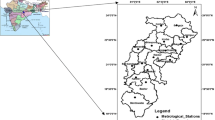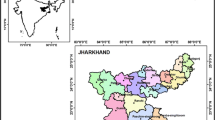Abstract
This paper provides an insight into the long-term trends of the four seasonal and annual precipitations in various climatological regions and sub-regions in India. The trends were useful to investigate whether Indian seasonal rainfall is changing in terms of magnitude or location-wise. Trends were assessed over the period of 1954–2003 using parametric ordinary least square fits and non-parametric Mann–Kendall technique. The trend significance was tested at the 95% confidence level. Apart from the trends for individual climatological regions in India and the average for the whole of India, trends were also specifically determined for the possible smaller geographical areas in order to understand how different the trends would be from the bigger spatial scales. The smaller geographical regions consist of the whole southwestern continental state of Kerala. It was shown that there are decreasing trends in the spring and monsoon rainfall and increasing trends in the autumn and winter rainfalls. These changes are not always homogeneous over various regions, even in the very short scales implying a careful regional analysis would be necessary for drawing conclusions regarding agro-ecological or other local projects requiring change in rainfall information. Furthermore, the differences between the trend magnitudes and directions from the two different methods are significantly small and fall well within the significance limit for all the cases investigated in Indian regions (except where noted).







Similar content being viewed by others
References
Alexander LV, Zhang X, Peterson TC, Caesar J, Gleason B et al (2006) Global observed changes in daily climate extremes of temperature and precipitation. J Geophys Res 111:D05109. doi:10.1029/2005JD006290
Asokan SM, Dutta D (2008) Analysis of water resources in the Mahanadi river basin, India under projected climate conditions. Hydrol Process 22:3589–3603. doi:10.1002/hyp. 6962
Brunetti M, Colacino M, Maugeri M, Nanni T (2001) Trends in the daily intensity of precipitation in Italy from 1951 to 1996. Int J Climatol 21:299–316
Cislaghi M, De Michele C, Ghezzi A, Rosso R (2005) Statistical assessment of trends and oscillations in rainfall dynamics: Analysis of long daily Italian series. Atmospheric Research 77:188–202
Cohn TA, Lins HF (2005) Nature’s style: naturally trendy. Geophysics Research Letter 32:L23402. doi:10.1029/2005GL024476
Cruz RV, Harasawa H, Lal M, Wu S, Anokhin Y, Punsalmaa B, Honda Y, Jafari M, Li C, Huu Ninh N (2007) Asia Climate Change 2007: Impacts, Adaptation and Vulnerability. In: Parry ML, Canziani OF, Palutikof JP, van der Linden PJ, Hanson CE (eds) Fourth Assessment Report of the Intergovernmental Panel on Climate Change. Cambridge University Press, Cambridge, UK, pp 469–506
CSIRO Australia (2008) Understanding autumn rain decline in SE Australia. ScienceDaily. Retrieved May 29, 2008.
Dash SK, Jenamani RK, Kalsi SR, Panda SK (2007) Some evidence of climate change in twentieth-century India. Climate Change 85:299–321
Ding Y, Wang Z, Sun Y (2008) Inter-decadal variation of the summer precipitation in East China and its association with decreasing Asian summer monsoon. Part I: observed evidences. Int J Climatol 28:1139–1161
Duan K, Yao T, Thompson LG (2006) Response of monsoon precipitation in the Himalayas to global warming. J Geophys Res 111:D19110. doi:10.1029/2006JD007084
Gibbons RD and Coleman DE (2001) Statistical Methods for Detection and Quantification of Environmental Contamination. Published by Wiley-IEEE, ISBN 0471255327.
Goswami BN, Venugopal V, Sengupta D, Madhusoodan MS, Xavier PK (2006) Increasing trend of extreme rain events over India in a warming environment. Science 314:1442–1445
Groisman PY, Knight RW, Karl TR (2001) Heavy precipitation and high stream flow in the contiguous United States: trends in the twentieth century. Bulletin of the American Meteorological Society 82(2):219–246
Guhathakurta P, Rajeevan M (2008) Trends in the rainfall pattern over India. Int J Climatol 28:1453–1469. doi:10.1002/joc.1640
Hamed KH, Rao AR (1998) A modified Mann–Kendall test for autocorrelated data. J Hydrol 204:182–196
Huth R, Pokorna L (2004) Parametric versus non-parametric estimates of climatic trends. Theoretical and Applied Climatology 77:107–112
Ihara C, Kushnir Y, Cane MA, De Lla Pena VH (2007) Indian summer monsoon rainfall and its link with ENSO and Indian Ocean climate indices. Int J Climatol 27:179–187
Immerzeel W (2008) Historical trends and future predictions of climate variability in the Brahmaputra basin. Int J Climatol 28:243–254
Karl TR, Knight RW, Plummer N (1995) Trends in high-frequency climate variability in the twentieth century. Nature 377:217–220
Lau KM, Wu HT (2007) Detecting trends in tropical rainfall characteristics, 1979–2003. Int J Climatol 27:979–988
Moberg A, Jones PD (2005) Trends in indices for extremes in daily temperature and precipitation in central and Western Europe 1901–1999. Int J Climatol 25:1149–1171
Moberg A, Jones PD, Lister D, Walther A, Brunet M et al (2006) Indices for daily temperature and precipitation extremes in Europe analysed for the period 1901–2000. J Geophys Res 111:D22106. doi:10.1029/2006JD007103
Mosmann V, Castro A, Fraile R, Dessens J, Sanchez JL (2004) Detection of statistically significant trends in the summer precipitation of mainland Spain. Atmospheric Research 70:43–53
Mugabe FT and Senzanje A (2003) Effect of rainfall variability on surface water resources: A case study from semiarid Zimbabwe. In: Monsoon Environments: Agricultural and Hydrological Impacts of Seasonal Variability and Climate Change, ICTP/PROMISE Conference.
Murphy BF, Timbal B (2008) A review of recent climate variability and climate change in south eastern Australia. Int J Climatol 28(7):859–879. doi:10.1002/joc.1627
Naidu CV, Rao BRS, Rao DVB (1999) Climatic trends and periodicities of annual rainfall over India. Meteorological Applications 6:395–404
NASA/Goddard Space Flight Center (2007) Long-term increase in rainfall seen in tropics. ScienceDaily. Retrieved April 28, 2008.
NOAA (2008) Current major flooding in U.S. A sign of things to come, NOAA Predicts. ScienceDaily. Retrieved April 28, 2008.
Pal I, Al-Tabbaa A (2009a) Regional trends of shifting mean monsoon rainfall, meteorological droughts and floods, and their teleconnections in India. Dynamics of Atmospheres and Oceans. doi:10.1016/j.dynatmoce.2009.07.001
Pal I, Al-Tabbaa A (2009b) Trends in seasonal precipitation extremes—an indicator of ‘climate change’ in Kerala, India. J Hydrol 367:62–69
Partal T, Kucuk M (2006) Long-term trend analysis using discrete wavelength components of annual precipitations measurements in Marmara region (Turkey). Phys Chem Earth 31:1189–1200
Purdue University (2000) La-Nina’s persistence may mean another dry summer. ScienceDaily. Retrieved April 28, 2008.
Rajeevan M, Bhate, J, Kale JD and Lal B (2005) Development of a high resolution daily gridded rainfall data for the Indian region, India Meteorological Department, Met. Monograph Climatology No. 22/2005, pp. 26.
Rajeevan M, Bhate, J, Kale JD and Lal B (2006) A high resolution daily gridded rainfall for the Indian region: analysis of break and active monsoon spells. Current Science.
Ramesh KV, Goswami P (2007) Reduction in temporal and spatial extent of the Indian summer monsoon. Geophys Res Lett 34:L23704. doi:10.1029/2007GL031613
Revadekar JV, Kulkarni A (2008) The El-Niño-Southern Oscillation and winter precipitation extremes over India. Int J Climatol 28:1445–1452. doi:10.1002/joc.1639
Roux PCL, McGeoch MA (2008) Changes in climate extremes, variability and signature on sub-Antarctic Marion Island. Climate Change 86:309–329
Roxy M, Tanimoto Y (2007) Role of SST over the Indian Ocean in influencing the intraseasonal variability of the Indian summer monsoon. J Meteorol Soc Jpn 85(3):349–358
Rupa Kumar K, Pant GB, Parthasarathy B, Sontakke NA (2007) Spatial and subseasonal patterns of the long-term trends of Indian summer monsoon rainfall. Int J Climatol 12(3):257–268
Singh GP, Oh J (2007) Impact of Indian Ocean sea-surface temperature anomaly on Indian summer monsoon precipitation using a regional climate model. Int J Climatol 27:1455–1465
Singh P, Kumar V, Thomas T, Arora M (2008) Changes in rainfall and relative humidity in northwest and central India. Hydrol Process 22(16):2982–2992. doi:10.1002/hyp. 6871
Soman MK, Krishna Kumar K, Singh N (1988) Decreasing trend in the rainfall of Kerala. Current Science 57(1):7–12
U.S. Geological Survey (1999) 1999 Summer drought may become century’s worst—mid Atlantic region experiencing most dramatic effects. ScienceDaily. Retrieved April 28, 2008.
Wilcox RR (1998) A note on the Theil-Sen regression estimator when the regressor is random and the error term is heteroscedastic. Biometrical Journal 40:261–268
Wu R, Kirtman BP (2006) Two types of dry Indian summer monsoons. July Report, Center for Ocean–Land–Atmosphere Studies. George Mason University, Maryland
WWF (2007) Indonesia at risk: climate change threatens people and nature. ScienceDaily. Retrieved April 28, 2008.
Zubair L, Siriwardhana M, Chandimala J, Yahiya Z (2008) Predictability of Sri Lankan rainfall based on ENSO. Int J Climatol 28:91–101
Author information
Authors and Affiliations
Corresponding author
Rights and permissions
About this article
Cite this article
Pal, I., Al-Tabbaa, A. Assessing seasonal precipitation trends in India using parametric and non-parametric statistical techniques. Theor Appl Climatol 103, 1–11 (2011). https://doi.org/10.1007/s00704-010-0277-8
Received:
Accepted:
Published:
Issue Date:
DOI: https://doi.org/10.1007/s00704-010-0277-8




